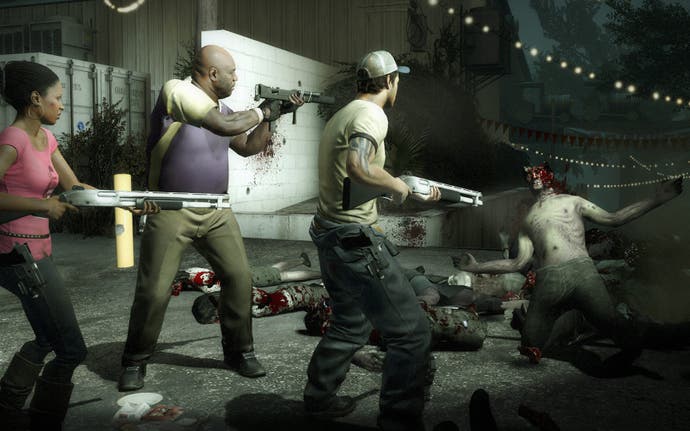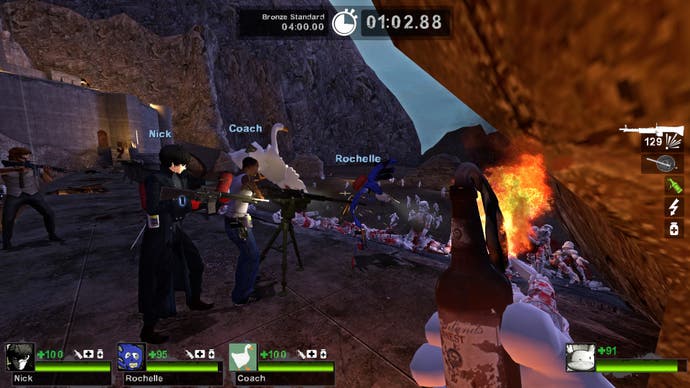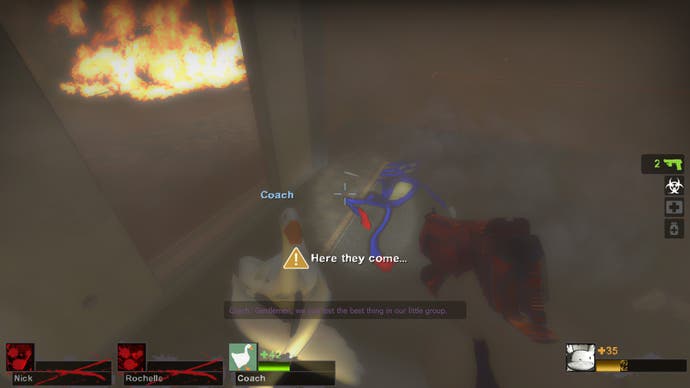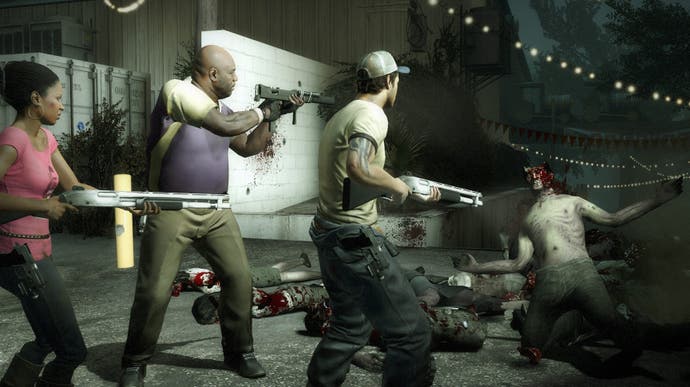As Left 4 Dead 2 turns 10, we speak to its creators about the Valve game that won't die
The dawn of the dead.
When you get to the end of a hard-fought round in Left 4 Dead 2, you're usually crawling towards a rugged red door. Maybe there's only two of your zombie-slaying quartet left... your health bars stripped away by the horde, your eyesight drained of colour, signalling that one more knockdown equals permadeath. If you're lucky, you push through the pain and make it into the safe room on borrowed time, grab some ammo and shoot the charging zombies to carve a safe route for the rest of your team.
That's unless you're playing Funny Doors. Funny Doors dictates that if you get into the safe room before a fellow survivor, in spite of earning those precious 25 points for letting them live to see the next round, you must hammer the E button to open and close the safe room door as they approach, turning the final moments of each round into one hilarious test of strength.
Left 4 Dead 2's safe room doors have a serious heft to them, and as such, each swing animation creates a tiny window of opportunity for the survivor to get past your self-flagellating trap as they howl at you on comms. Usually, they'll get pummeled by a charger and you'll have to head out and save them. It's an evil habit. Barbaric, you could say, but it's one of many peculiar bits of communal context that have ensured this game has become a weekly inevitability where many modern titles have failed to hold our attention.
As of 17th November, Valve's atomic zombie smasher is 10 years old. Left 4 Dead 2 can get its ears pierced or be convicted of a crime, yet if you choose to boot it up for a night of nostalgia, you'll be surprised. As you're seeking out that elusive perfect score and being added to rage quit Steam groups, you'll notice it feels as spry as it was in 2009. Somehow it still hasn't fallen out of the top 100 games played on the platform, averaging around 10,000 players a day.

Tom Leonard was part of the Ravenholm cabal during Half-Life 2's development and later led Valve's experimental R&D project, the Directed Design Experiments. Valve's pipeline shut down for a few months and the developers split off into small groups to work on creatively invigorating projects. He tells me the "non-crunchy" way in which those experiments were handled influenced the way Valve approached the sequel to Left 4 Dead.
"There's almost like a deafening silence after you push to get a game out the door. But you don't want to move straight into a crunch," Leonard says.
"Left 4 Dead 1 was a pretty crazy project in terms of getting it pulled together. It was arguable that none of us understood in a formal sense how the game works, it was just like... 'Hey, it works!' "
A small team was then formed of various disciplines who worked on the original Left 4 Dead. Following interviews with developers about how long it took to create content and the work hours necessary, the group analysed the game and came up with a "game design document after the fact," a blueprint for creating Left 4 Dead 2 in a more healthy fashion.
"The A.I Director opened the door for a loose and fluid form of game design. It wasn't quite as rigid as doing Half-Life 2 style linear gameplay," Leonard says. "So I proposed to people, 'Hey, why don't we see if we can do it in a year, and see if we can do it without people crunching?' "
Another key member of the development team was Chet Faliszek, a former Valve veteran who helped write Half-Life 2's episodes and Portal before moving on to Left 4 Dead.
"It was a very rough experience trying to get an engine that didn't want to ship on Xbox... to ship on Xbox," he tells me. "We were also trying to squash bugs in a game where it's different every time you play it, so we came off of that and it was a pretty exhausting experience. So some of us internally thought, 'Hey, you know what, we know how to do it.' And we thought we could make Left 4 Dead 2 in a very un-Valve way of 'Quickly.' "
During the iteration process, the team didn't see anything wrong with the formula but wanted to address gaps in the game mechanics. "The first time you play, you get the concept of everything on that first table: a gun and a health pack," Faliszek says. "So the first time you see a zombie, you're not like, 'Oh my god, what should I do?' "
The developers had implemented a skill tree system and a series of accessory items, including end of match rewards like a 'Hot Meal' that would restore you to full health. Trip-mine style tools and remote explosives were also considered, but as they attempted to expand the player toolset, they came to a realisation. "Once we got to the clarity at the core of (Left 4 Dead 2), we started to realise that those things weren't meaningful," Leonard says.
"We're not going to compete against the super hardcore shooters," Faliszek says. "We made Counter-Strike, we don't need to make Counter-Strike co-op."
One of the only things the team couldn't implement came from the mind of WETA alum Gray Horsfield, who was itching to create an experience where you could chip off parts of the tank's body, turning it into destructive pieces rather than it being a big bullet sponge.
Yet given that development had a very scheduled approach, there wasn't much left on the cutting room floor. "We didn't cut things as much as morph them," Faliszek says. "We came up with creatures to fix problems we were having, like in Left 4 Dead 1 people were stacked on top of each other (Shiva Stacking), so we created The Spitter. Creature design was really about reacting to player behaviour."
Leonard tells me a story about the letters the team used to receive at Valve about Left 4 Dead as the phenomenon grew, with a particular one arriving from a soldier stationed in Afghanistan, thanking the team for a game that lets him spend time with his spouse at home.
"People can get together and talk and have experiences in Left 4 Dead but not talk about the bombs or the kids or the bills, right?" Leonard says. "It just created this zone, this alternate reality where people could hang out and be relieved of exterior burdens. It's a form of team escapism."
Leonard helped to integrate Left 4 Dead's infamous A.I. director with Valve's scripting system and later doled out those creation tools to the community, who have responded with thousands of mods and custom campaigns.
To a connoisseur such as myself, the concept of swapping the tank with Shrek and hurling emotionless Donkey rocks is old news. For me, it doesn't get much better than having children's TV presenter Michael Rosen replace the model and voice of the Hunter, or swapping out the hordes of common infected for Bionicles. If you're wondering whether the mod scene is still alive in 2019, consider this asset swap that turns gym teacher Coach into that no good horrible goose we've all been obsessing over.
"There's one that makes the zombies cats. If anything it shows that you should just be free with your game," Faliszek tells me.
"Don't worry about letting players change things or putting your characters in other games as if it will kill the IP," he adds. "Don't be precious with it. Let the computing community have fun with it because it's theirs as well!"

Many players have gravitated towards the characters of Left 4 Dead 2 thanks to their memorable voice lines and backstories. Faliszek tells me that when working on a co-op game he has to write more but say less. "You have to be ok with the player missing what gets said because if you're playing with your friends, someone's screwing around. The loose rule is that if you say something to the player three times you hope one of those times it hits."
It's also about thinking how protagonists in an apocalyptic situation would talk to each other. "If you're in the situation you barely keep talking about the situation, right? You just talk about whatever you're dealing with. So we tried to make the characters do that, and then leave the rest of it, but then surface some of that through the writing on the safe room walls and combat spaces."
After 10 years of play, there's still oodles of personal pride and tension in a multiplayer game of Left 4 Dead 2. There's nothing sweeter than making your opponents rage quit early in a match, but there's also nothing worse than the tears on the pillow when you lose by mere digits and bow out for the night, the erratic, inexplicable score ticker doling out the final judgment on a close Bridge finale. "Versus mode works because you get to be such a jerk," Faliszek says. "When you pull off the combos and hear that 'ding ding ding,' it just feels so good."

Despite being the most iconic set piece in the game, The Bridge was actually the first thing the team made in Left 4 Dead 2. Faliszek explains: "All these finales were very stationary and focused on defending, so how do we get it to be around movement?"
Based on the Mississippi Bridge and the Huey P. Bridge in Louisiana, the final mission is a huddled rush across a broken strait, which is easy bait for insta-kills, where chargers and jockeys can cooperate to send you hurtling into the drink below. If you miss in Versus, that's fine, you can just say you were 'creating opportunity'."
According to Leonard, the main focus in approaching the sequel was to make these crescendos more "aesthetically juicy," but many of them didn't come together until the last minute.
The most difficult to orchestrate was the Dark Carnival Finale, a virtual performance well before Marshmello took the stage in Fortnite. Leonard tells me a lot of the finales in-game were beyond the boundaries of the A.I. director, and to truly kickstart the rock concert he had to use his toolset to write code live while people were playing.
Left 4 Dead 2's tense finales wouldn't be the same without its A.I. controlled survivors either, who never cease to inject some unpredictable chaos into the fray. The main advantage to these survivors is they shoot to kill and their pinpoint headshots are unmatched (Bill in particular seems to be using an aimbot). Yet, if you've played you've no doubt fumed about how inexplicably clumsy they can be when a team is trying to move fast.
This has led to a tactic known as 'poaching Coach' - focusing on the opposing team's lone A.I. companion who can't possibly stay in line with the speed and commands of their fellow human players. Frustration aside, they'll always be the first person to heal you when you're low on health, whereas human players would rather double drop on medkits to spite each other. In asking Leonard I'm told the A.I. survivors were the work of the architect of the A.I. Director, Mike Booth, and are derived from his work creating bots for the Xbox version of Counter-Strike, which explains the incredible accuracy.

The future of Left 4 Dead 2 and games that echo its sensibilities appear to be in fine hands. While the series is on hold as Valve focuses on other projects, the original team behind Left 4 Dead has since spun out into Turtle Rock Studios, who are now working on Back 4 Blood, an original IP and spiritual successor to the series they helped create. Faliszek himself is charting a similar course at Stray Bombay working on a four-player shooter with Riot's Kimberley Voll.
Remarkably, Left 4 Dead 2 has managed to survive for a decade without the hallmarks of modern co-op. It's not a live service and it doesn't have any progression mechanics or skill trees. It's not trying to make you input your bank details, and there's little esports potential. So how come tens of thousands of people still keep it alive?
Leonard summed it up with a simple mantra, a principle barked out all too often in my own matches and a design ethos that has kept the game so tantalisingly exciting whilst still being mechanically simple . "Stay together or die."




